The first schematic describes a 100 watt Guitar amplifier circuit which can be used mainly for amplifying guitar sound and also a public address systems. The next schematic in this article explains yet another guitar amplifier enhanced with fuzz effect generator and treble booster circuits.
To test its ruggedness, the unit is designed without any ancillary equipment like volume control. Furthermore, an appropriate pre-amplifier must be installed beforehand, which is comprehensively I have explained in this article.
Not only does the exterior look tough, but also the performance of this amplifier that manages over 100 watts endlessly using a sine-wave input.
The frequency response is undeniably flat at 50 Hz to 20 kHz, with a total harmonic distortion of less than 0.5% (0.1 W to 80 W).
You can connect multiple speakers from this amplifier on one condition; the total impedance must be equal or more than 4 Ω.
How Does it Work

Referring to the above schematic, the guitar power amplifier amplifier employs a quasi-complimentary symmetry, output phase and a differential input phase.
Parallel output transistors are used for an enhanced output capacity while transistors Q6 and Q7 connected in Darlington pair deliver a current gain.
Around 10 mA is provided by the current regulator Q3. This controlled current channels through Q4 and activates the bias for the output stage, and Q5.
The collector voltage at Q5 is determined by its base-emitter voltage. An extremely high voltage gain is present in this transistor because it is operating almost at constant current.
This high gain is attenuated at large frequencies by capacitor C7.
The differential pair Q1 and Q2 controls transistor Q5. As a result of the negative feedback through R7 and R9, Q1 and Q2 function like an error amplifier. So, it attempts to retain the voltage at its two inputs at the bases of Q1 and Q2 constant.
Therefore, the output voltage is made equal to the input voltage multiplied by (R9+R7)/R7.
Resultantly, the amplifier will have a voltage gain of around 22. Changing the value of R7 will allow the voltage gain to vary.
An apt adjustment must also be made to C6 because R7/C6 regulate the lower -3dB point. You must ensure to not change the value of R9.
Quiescent Current Set Up
RV1 which is a 470 Ohms preset, sets the output bias current which is essential to avoid cross-over distortion. This may be done with the help of the following points.
Short the speaker points together, and also the input points together.
Attach, small 100 mA or 50 mA filament bulbs in series with the two supply line inputs (-40 V and +40 V lines).
Now, switch ON power, the bulbs might show high brightness.
Slowly adjust RV1 until the bulbs are shut off or the brightness is reduced to some minimal level.
That's all, the quiescent current setting s complete.
Construction Details
The 100 watt guitar amplifier circuit can be easily assembled because the electronic components are plugged directly on the PCB.
Begin by soldering the electronic parts on the PCB by referring to the plan shown in the below image.
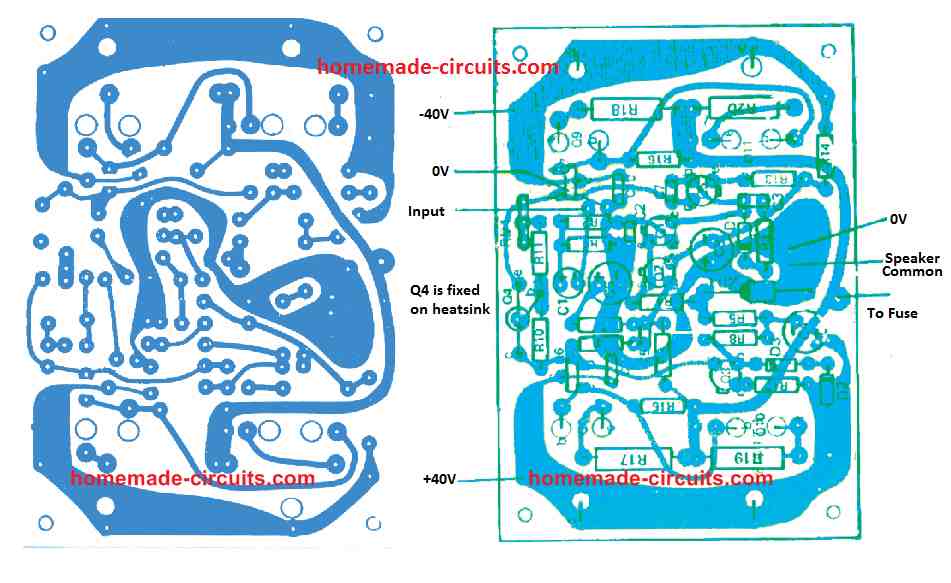
Ensure that all capacitors, diodes and transistors are correctly placed. On Q3 and Q5, metal “fin” type of heatsinks are utilized. Double-check that the heatsink has enough space between the other parts.
Another heatsink that is insulated by mica washers is mounted between Q6 and Q7.
Keep in mind that the heatsink will be a little slanted and the transistor somewhat curved. This is to give space for fastening the heatsink to the “metal side” of the transistors. Always make sure that insulating washers are installed.
The PCB for this guitar amplifier circuit should be fitted against the lid of the metal box and short connecting leads should be connected between the boards to the transistors’ outputs which are plugged on the flip side of this lid.
To make sure the PCB does not touch with the inner face of the lid, countersunk screws and washers are utilized. It is fundamental to install the fasteners at this stage but avoid fixing the board altogether.
Using the countersunk screw and insulating spacers, the heatsink for Q4 must be secured to the lid.
The heatsinks for the output transistors must be installed now, and ensure the transistors are in their right locations. Remember to include the insulating washers.
The short leads must be connected to the emitter, base and collector of the output transistors. This connection to the collectors is done using the transistor mounting screw.
Next, firmly attach transistor Q4 into its heatsink. In the PCB, place the metal joining pins for terminating connections to the output transistors Q8, Q9, Q10 and Q11. The positions of the pin are visibly etched on the PCB overlay.
After that, plug all the leads from the power supply into the PCB. Then, fix the board on top of the leads from the output transistors and fasten them tightly.
Solder the leads from the diverse external connections to the selected pins on the board. Try not to turn the wire around the pins by more than half a turn. Else, when you need to detach it (for some reasons), it will be tough.
Finally, assemble all remaining parts. Ensure the mains earth lead is firmly fixed to the case as it acts as a transformer shield too. The input shield must be earthed to the case directly at the input socket.
Guitar Amplifier Circuit with Fuzz Effect and Treble Booster
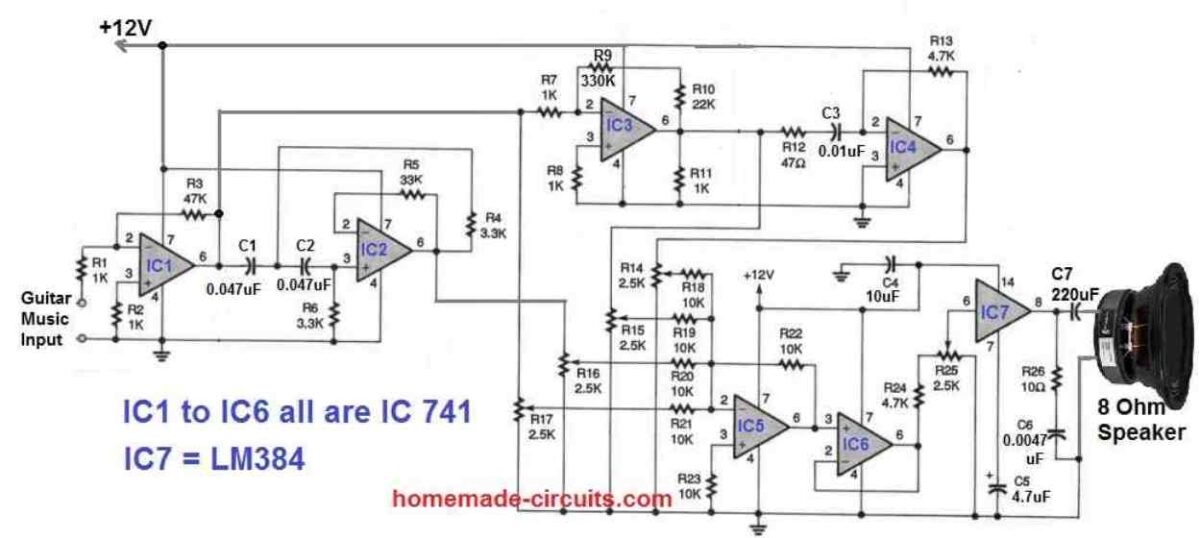
Referring to the above guitar amplifier with fuzz effect and treble booster schematic, we can understand the working of the circuit with the following points:
The output from the guitar is fed to the 741-based preamp 1C1. The output of the preamp is supplied to the mixer directly.
It is also fed to a high-pass filter built around IC2 that acts like a treble booster, and a high-gain amp for clipping, in order to generate the "fuzz." effect. The mixer receives the filtered output of IC2.
The output of the high-gain amplifier is furthermore divided between a mixer and a differentiator.
This generates a spiking waveform from IC3's squared output.
The output of integrated circuit IC4 also connects to the mixer. As a result, the mixer receives dynamic, in-phase inputs that can be clipped, fuzzed, differentiated, or pointy, as well as with an enhanced treble effect.
Setting up several mixer inputs is half the joy of using this fuzz effect enhanced guitar amplifier circuit! The output of the mixer connects to the buffer IC6.
The buffered output connects to IC7, the LM384 power audio amp, through a volume-control potentiometer. Ensure that IC7's unused pins are all grounded.
Finally your guitar skills is displayed to everybody nearby through an 8-ohm speaker, with enhanced fuzz effect and a truly boosted treble output.
Preamplifier Circuit
The level of output signal delivered by most electric guitars will certainly not be sufficient to overdrive the above exlained 100 watt guitar amplifier.
This particular overdriving is a crucial aspect for a perfect, final guitar output.
Therefore, a guitar preamplifier becomes imperative, between the guitar and the main power amp.
The preamplifier circuit described below enhances the small guitar electrical string signals to a higher level.
However, the input stage of the guitar amplifier might clip the output from the preamplifier, if the signal exceeds the required limit.
As a possible solution to the clipping, the gain of the preamplifier could be fixed between 3 and 11 times.
The complete circuit layout is actually quite straightforward.
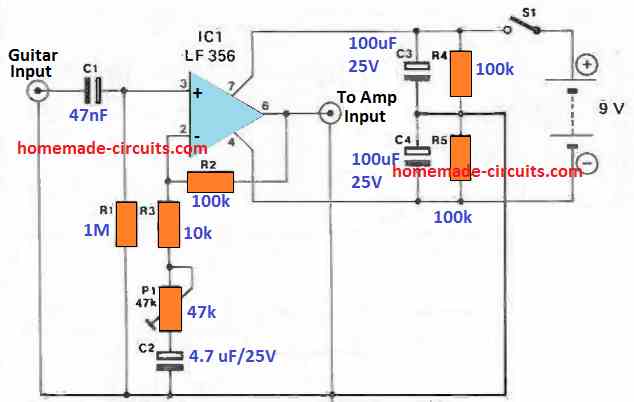
Just one LF 356 delivers the required amplification, that is determined by the ratio of R2 + R3 + P1 to R3 + P1. The input impedance, which, at 1 M, may be pretty high, is specified by R1 since the op -amp includes FET inputs.
This can be a appropriate impedance for the majority of guitar pick-ups. A 9 V battery supplies the power supply which is transformed into a balanced +/ -4.5 V for the op-amp through R4, R5, C3, and C4.
Current draw of this guitar preamplifier will be approximately 5 mA. The design including battery could simply be installed inside a tiny enclosure.
If a plug/socket connectors are fitted on the cabinet, the preamp can easily be hooked up into the guitar.
If this is executed, preset P1 could be substituted with any standard potentiometer to facilitate quick amplification control using the pot knob protruding from the case.
Improved Guitar Preamp Circuit
The following two designs were contributed by Mr. Paul, who is one of the avid readers of this blog.
The details are presented below, as sent by Mr. Paul through email:
I wish to submit to you my schematic for a guitar Preamp. This Preamp incorporates a very unique way of cancelling any noise on the power supply.
The 33K resistors are in parallel, because of the zero resistance of the power supply. This forms a gain determining resistance of 16.5K.
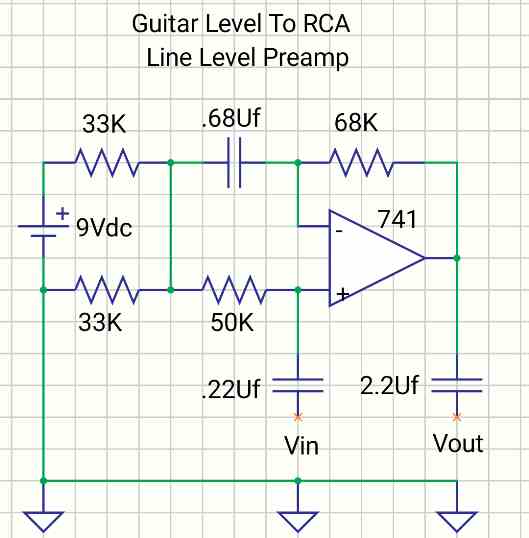
A 50K resistor is placed in series with that 16.5K to form a bias resistance of 66.5K that is applied to the non inverting input.
Should there be any noise on the power supply, the noise divides by two where the 33K resistors meet.
That noise is coupled through the 0.68uF capacitor to the inverting input, and also coupled through the 50K resistor to the non inverting input.
The amplified noises cancel each other at the output. The 0.22Uf capacitor ac couples the audio input signal.
The 2.2uF capacitor ac couples the audio output signal.
Voltage gain = 0.75 × ((1+(68000/16500)). 3.841 as shown. (11.7 db).
This is because 25% of my audio input signal is ac coupled to the inverting input.
Preamp with Buffered Outputs
My original Guitar Preamp just got better. This Preamp has the same power supply noise cancellation as the original circuit.
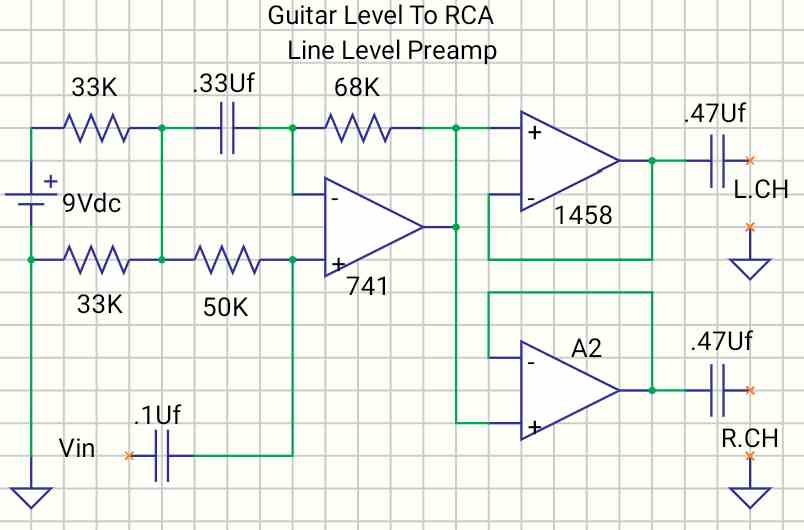
The difference is that this circuit has two buffered outputs to drive the left and right channel RCA inputs on Home Stereo or P.A. equipment. I will attach both the original and improved schematics for you to compare.
Gutar Fuzz Circuit
The following image shows how to build a guitar fuzz circuit for creating fuzzy sound output from the guitar strings

Hi,
I would like to assemble the 100 Watt Guitar Amplifier Circuit . Is there any available pcb ready to install the parts for this amp.
Many thanks
Matt
Hi, I appreciate your interest, however, unfortunately we do not have the PCB design for the above project with us at this moment.